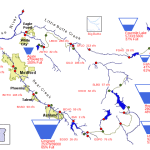Why Are Ashland’s Water Rates Going Through the Ceiling with No End in Sight?
Why Are Ashland’s Water Rates Going Through the Ceiling with No End in Sight?
As a member of the Ashland City Council in 2012, I voted in favor of a new water treatment plant to replace the existing 40-year-old plant. The new plant proposed at the time would save Ashland from a water emergency, providing a secure water source if and when the need arose. The price tag―a whopping $25 million. However, subsequent infrastructure developments have changed our situation regarding water, and I believe the city and its citizens must now review this decision and its costs.
Most significant in terms of infrastructure development, in 2015-2017, the $10 million Talent Ashland Phoenix (TAP) water line was constructed, linking Ashland to an abundant and reliable, albeit expensive, supply of water from the Medford Water District. TAP could potentially supply our city with an additional 2.1 million gallons per day. During winter months from November through March, Ashland uses an average of 1.9 million gallons a day. The rest of the year it grows to a max of 4.5 million gallons a day; then it declines slowly down to the 1.9 millionIn the early winter months. The increase is due to irrigation or watering our gardens and trees. By the way, we are really good at conservation. We took summer water demand down from 6+ million gallons a day to 4.5 million gallons a day in a matter of a year. With the TAP water now available to Ashland in the event of an emergency or for any use, it seems clear we no longer need the $25 million water treatment plant to meet emergency demand.
Ashland’s current water treatment plant is 40 years old and, despite its advanced age, is working well. What the plant needs is retrofitting to protect it from a natural disaster―flood, fire, or earthquake. Estimates for such retrofitting run between $4 and $6 million. We would likely maintain this plant even if the decision were made to move ahead with the new plant. The question is, how much redundancy do we need, and at what cost?
Let’s examine costs. In the 2012 master plan, TAP was estimated to cost $2 million; in reality, TAP water costs $10 million over the two years from 2015-2017. What if the $25 million estimate for the new plant increased just as TAP costs did? We would gain nothing in terms of production with the new plant; it would still produce 2.5 million gallons a day just as our current plant reliably produces. So there is nothing to gain from a new plant except huge increases in our water rates.
Our city’s population has grown very little over the past two decades. According to US Census data, Ashland’s population in 2000 was 19,547. Ashland’s Chamber of Commerce estimates our population today to be 20,412, a growth of just 865 residents over the past seventeen years, representing an annual growth of just 50 people per year. Over the past four years, our water utility rates have risen 10% every year. These rates will continue to rise, however, without the new plant, rate should increase between 6% and 8% per year for the foreseeable future. With the new plant, the sky’s the limit.
One of the main reasons I supported the new water treatment plant in 2012 was that, at that time, we had no emergency source of water. Now that TAP addresses that need, and given the exorbitant price tag, cost forecasts, and slowing increase in water demand due to population stability, I must conclude that the wiser decision would be to retrofit our existing water plant and shelve the $25 million water treatment plant indefinitely.
The Ashland Water Advisory Ad Hoc Committee should immediately begin a reassessment of the new water treatment plant and, if the decision to move ahead with the new plant is reached, fully explain to the citizens why we must bear such a cost, especially when reviewed against the alternatives. We deserve no less.
Carol Voisin
Ashland





